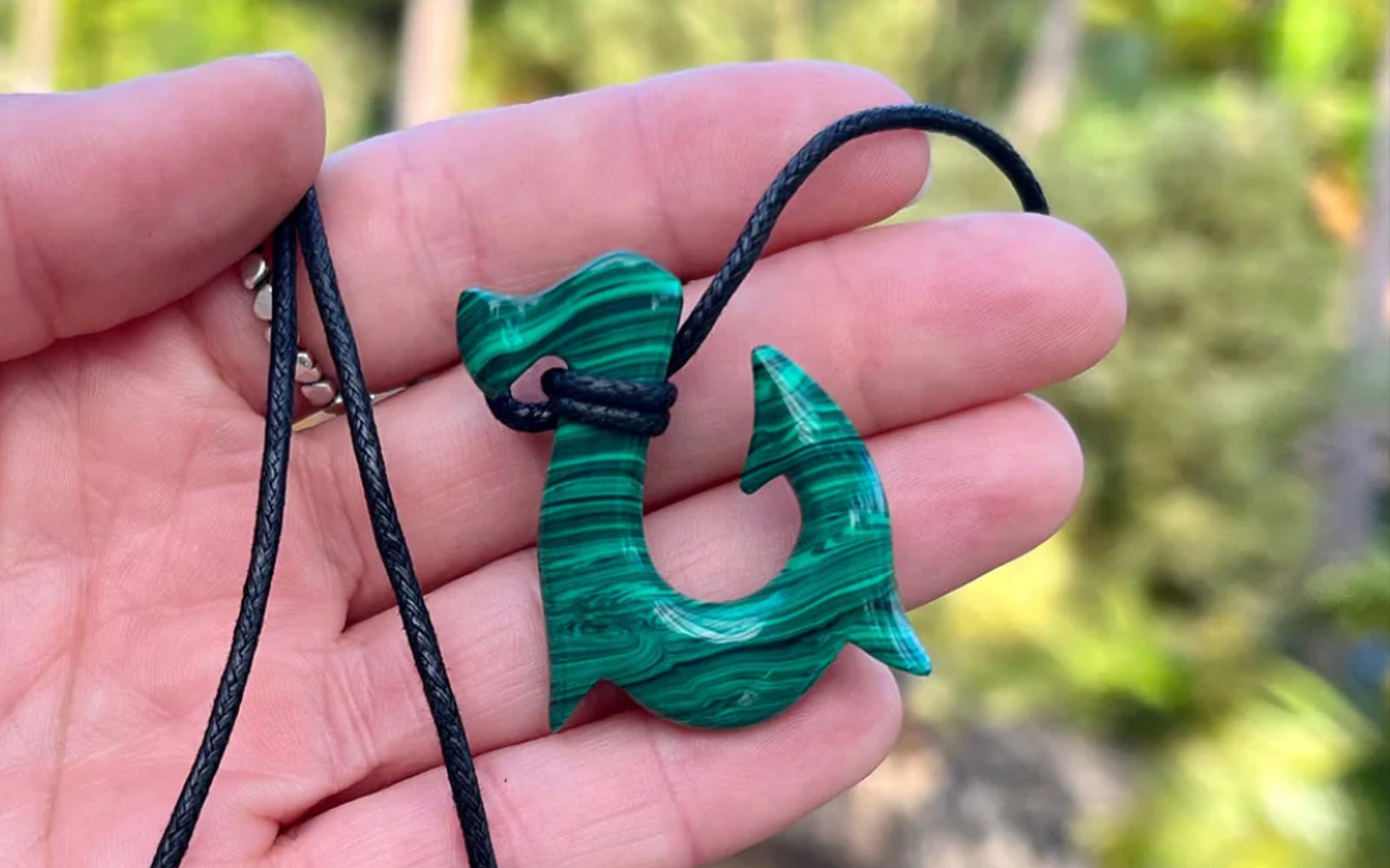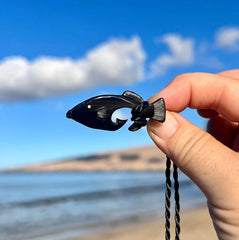
Maui Hooks: Symbols of Strength and Culture
Hawaii is renowned for its stunning natural beauty, with its pristine beaches, lush rainforests, and dramatic volcanic landscapes captivating visitors from around the world. The islands offer diverse environments, from the vibrant coral reefs teeming with marine life to the majestic mountains and waterfalls of the interior. Beyond its breathtaking scenery, the history of these islands boasts a rich cultural heritage, blending native Hawaiian traditions with influences from various cultures that have settled there.
The Maui Hook is a symbol deeply embedded in Hawaiian mythology, culture, and history. This iconic artifact carries with it stories of legendary demigods, traditional fishing practices, and the sustainable lifestyle of the Hawaiian people.
What is the Maui Hook?
The Maui fish hook, known as "makau" in Hawaiian, has long been a crucial tool for the survival and prosperity of the Hawaiian people. While its symbolic and cultural significance is widely recognized, its practical applications for fishing have been equally vital throughout history.
However, it is more than just a fishing tool; the Maui Hook symbolizes strength, prosperity, and a deep connection to the ocean. Its legacy is rooted in ancient legends, traditional craftsmanship, and its enduring presence in contemporary Hawaiian culture.
History of the Maui Hook
The most famous story associated with the Maui Hook revolves around the demigod Maui, a central figure in Polynesian mythology. According to legend, Maui possessed a magical fish hook called “Manaiakalani.”
It is said that Maui fished up the Hawaiian Islands from the ocean depths with this hook. One version of the tale claims that Maui also used the hook to slow down the sun and lengthen the days, giving his people more time to fish and farm.
Symbolism and Cultural Significance of the Maui Hook
The fish hook symbolizes the importance of the ocean to the Hawaiian people. Many people wear a fishing hook necklace to feel a deeper connection between themselves and the ocean. Beyond that, it can demonstrate the following qualities:
- Energy
- Prosperity
- Strength
- Good luck
- Safe passage over water
How is a Maui Hook Made?
The art of creating a hand-carved hook requires a blend of artistic vision and practical skill. This meticulous art has been passed down through generations, preserving the cultural heritage and functional design of these iconic tools. The process typically begins with selecting the appropriate material, gathering the required tools, and finally, establishing your techniques.
What Materials Are Maui Hooks Made From?
The choice of selecting the appropriate materials is critical, as it affects both the durability and functionality of the final product. Traditional materials used in crafting Maui fish hooks include several options, each with its own unique properties.
- Bone: Often sourced from animals such as pigs, dogs, or even humans, bone is prized for its strength and durability.
- Wood: Hardwoods like koa or ironwood are preferred due to their resilience and ease of carving. Wood is the most common material used for Maui Hooks.
- Shell: Certain types of shells, such as mother-of-pearl, are used for both their strength and aesthetic qualities.
- Stone: Although less common due to the difficulty in shaping, stone can also be used for its toughness and traditional significance.
What Tools Do You Need to Make a Maui Hook?
Traditional tools for making a Maui fish hook are an essential part of the craft, with each playing an important role in transforming raw materials into a functional and beautiful final product. These tools have evolved over generations, reflecting the knowledge and skills of Hawaiian artisans over the years. Here are some of the traditional tools used in this intricate process:
- Knives
- Gouges and chisels
- Files and rasps
- Awls and drills
- Sandpaper or abrasive stone
The Various Techniques Used to Create a Maui Hook
A series of intricate techniques ensures that each hook is functional for fishing and a piece of cultural heritage. Here’s a deeper look at those techniques!
- Design and Planning: Artisans sketch their designs before carving, considering both the functional aspects and the artistic elements.
- Rough Carving: The initial stage involves removing large sections of material to form the basic shape of the hook.
- Detail Carving: Finer tools are used to add intricate details and refine the shape.
- Finishing: The final steps to the fishing hook necklace include sanding to smooth the surface and applying finishes such as oils or varnishes to protect the hook and enhance its appearance.
Maui Fish Hook Jewelry
While the Maui Hook has practical applications, one of the most popular uses is wearing it as jewelry. The iconic pieces have a universal appeal and transcend cultural boundaries. People who feel deeply connected to the Hawaiian culture or simply align with the symbolism may purchase a necklace even if they are not Native Hawaiians.
Skillfully crafted with precise attention to detail, fishing hook necklaces feature a distinctive hook shape and often include intricate designs or precious gemstones. New techniques in modern times have allowed for unique varieties of traditional necklaces, such as our Malachite Composite Hand-Carved Maui Fish Hook, which combines the bright green copper gemstone with the iconic motif of the fish hook.
How to Style Fishing Hook Necklaces
The great thing about Maui Hook jewelry is that it can be worn in both casual and formal settings. Whether you are headed to the beach or attending a wedding, there are truly no hard and fast rules for wearing the jewelry. However, there are a few traditional practices and modern adaptations that you can try.
Fishing Hook Necklaces in a Casual Setting
Fishing hook necklaces in a casual setting add a rustic charm and a hint of adventure to any outfit. They effortlessly blend with relaxed attire for a laid-back, coastal-inspired look. Try these styling suggestions next time you are stuck on what to wear:
- Layering: Pair a different type of necklace with a fishing hook necklace for a layered look. Choose different lengths to create depth and visual interest.
- Bohemian Vibes: To create a bohemian look, combine the pendant with other natural elements, such as leather bracelets or wooden bangles.
- Everyday Elegance: Choose a simple gold or sterling silver hook on a delicate chain to create a minimalist look that adds a touch of elegance to your everyday outfit.
How to Dress Up a Fishing Hook Necklace
Whether you’re attending a formal event or simply want to elevate your everyday look, dressing up a fishing hook necklace transforms it from a casual accessory into a distinctive statement of style and adventure. Here are a few tips for elevating your style:
- Mixed Metals: Experimenting with mixed metals by wearing your fishing hook necklace alongside other metallic accessories like a watch or a bracelet can add a modern twist to the look while maintaining a professional appearance.
- Statement Piece: Opt for a larger Maui Hook pendant as a focal point. Keep the rest of your accessories simple to make the necklace stand out and create a sophisticated statement.
- Updo and Necklines: Wearing your hair up can showcase the necklace in an elegant way. Additionally, V-neck, scoop neck, button-up, or strapless dresses and shirts will draw attention to the pendant and create a flattering silhouette.
- Bold and Beautiful: To dress up the necklace for a formal event like a gala or black-tie wedding, pair a Maui Hook necklace featuring gemstones and delicate designs with an evening gown, cocktail dress, or tux.
3 Traditional Ways to Wear the Maui Hook Necklace
Wearing the Maui Hook necklace in traditional ways connects wearers to Hawaii's rich cultural heritage and deep-seated reverence for the ocean. If you are looking for inspiration to further connect with Hawaiian culture, we have a few suggestions.
- Traditional Attire: If you attend a cultural event or festival, wear your fishing hook necklace with traditional Hawaiian attire such as a pa'u (skirt), mu'umu'u (dress), or aloha shirt.
- Floral Accents: Enhance your look with fresh or silk flower accessories, such as a haku lei (flower crown). These floral accents complement the natural themes of the necklace and add a festive touch to your ensemble.
- Layer With Leis: Layer your pendant with traditional lei necklaces made from flowers, shells, or kukui nuts. This creates a vibrant and textured look that reflects the festive atmosphere of Hawaiian celebrations.
However you choose to wear the necklace, the most important thing is that you feel a personal connection. Whether for its design, material, or cultural significance, this connection will enhance your confidence and enjoyment in wearing the jewelry.
3 Reasons to Wear the Maui Hook
The number one reason to wear a fishing hook necklace is simple; you love the look and want to honor the Hawaiian culture. However, similar to crystal healing power, these necklaces can have further meaning beyond practical applications and cultural significance.
1. Wear a Fishing Hook Necklace for Protection
The fish hook is a mental and physical symbol of strength, as fishing was historically vital to the survival of Hawaiian communities. For fishermen, a fish hook was said to keep them safe while at sea, allow them to overcome any challenges they faced, and provide for their families.
2. A Maui Hook Can Provide Safe Travels
Stemming from the legend of Maui, a fishing hook necklace is said to keep one safe during any type of travel and ensure they return home safely. Because of this, many people choose to wear one or keep one near them when they are on the go.
3. Connect to Nature with Fish Hook Necklaces
It’s clear that nature and the ocean play a large role in Hawaiian culture. Fishing hook necklaces serve as a reminder to respect the natural world and be mindful of humans' impact on it.
Our Favorite Handmade Maui Hooks
Each of our pieces has been hand-carved by a local Maui artist. With such an intricate and detailed process, you can guarantee that your fishing hook necklace is unique in its own way! While we love them all, these are a few that stand out;
- Sterling Silver Maui Hook Pendant: For a stylish design that pairs well with any look, this .925 sterling silver hook pendant is what you need. It’s durable, shiny, and perfect for everyday wear or special occasions. Slide it on your favorite chain or one of our necklaces and show off your treasured new accessory.
- Maui Fish Hook - Maui Axis Deer Antler: Axis Deer are traditionally native to India but were brought to Hawaii in 1860. As there are no native predators of the deer, the population has rapidly increased, providing artisans ample antlers for fishing hook necklaces. The white color of this necklace creates a simple and elegant look.
- Hand Carved Ray Peters Humuhumunukunukuapua’a Necklace: Representing the state fish of Hawaii, the humuhumunukunukuapua’a necklace is made from water buffalo horn. Water buffalos are the number one domesticated animal in the world and are suitable for tilling rice fields, so this necklace really incorporates elements that sustain Hawaiian culture.
- Koa Wood Maui Fish Hook: This piece of jewelry is a very traditional representation of fishing hook necklaces, as koa wood is the most common material used. If you want something simple and classic, this is the perfect selection.
Who Would Love a Fishing Hook Necklace Gift?
When selecting fishing hook necklaces as a gift, consider the recipient's personal interests, cultural background, and connection to the ocean and Hawaiian culture. Whether they wear it for its symbolic meaning, aesthetic appeal, or as a reminder of their journey, it carries a profound message of heritage, strength, and cultural appreciation.
At Whaler’s Locker, we have a wide assortment of Maui Hook necklaces and other items such as handcrafted knives and scrimshaw artwork that would make the perfect, unique Hawaiian gift. Check them out in our store or online and take a piece of the islands home with you.
Hand-carved Maui Hooks are a testament to human ingenuity and artistry. They connect us to our past, offering a glimpse into the lives and cultures of those who came before us. Today, they continue to provide practical use while symbolizing the timeless relationship between human beings and the natural world.








